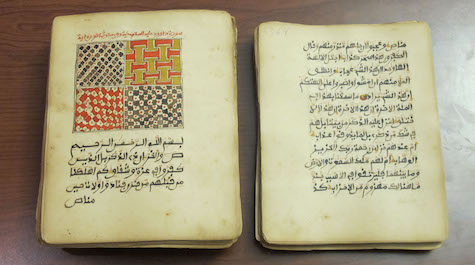Swem Special Collections purchased a 19th century Quran manuscript Sept. 19, the only Quran manuscript owned by the College.
This West African Quran manuscript is expected to unveil more details about enslaved Muslim African Americans and to diversify the collection of documents at the College of William and Mary.
Special Collections purchased the Quran manuscript on eBay at the request of religious studies professor Oludamini Ogunnaike and it arrived at Special Collections Sept. 30.
According to the description online and preliminary analysis, this manuscript was written during the 19th century in what is now Nigeria.
Because of its centrality to Islamic life, the Quran is considered the crucial text for the study of Islam.
For Muslims, the Quran is the literal word of God, and everything about it is sacred, including the calligraphy and the paper itself.
Beyond its religious significance, this manuscript could also play a crucial role in further research on African Muslims.
Ogunnaike said that the individuality of the manuscript could provide more information about African Muslims, which could not be easily found out through reading a printed Quran.
The way in which this Quran had been divided up [in 60 parts] might tell us something about the particular West African understanding of the Quran and how it was used, which we don’t know about.” Ogunnaike said. “Also some of the facts, that the word ‘Muhamad’ was in red and nothing else in the text was in red, might tell us something about the particular beliefs and interpretation of Islam.”
“The way in which this Quran had been divided up [in 60 parts] might tell us something about the particular West African understanding of the Quran and how it was used, which we don’t know about.” Ogunnaike said. “Also some of the facts, that the word ‘Muhamad’ was in red and nothing else in the text was in red, might tell us something about the particular beliefs and interpretation of Islam.”
In addition, Ogunnaike said he believed the unique features discovered in this Quran will contribute to the understanding of enslaved African Americans.
“If there are some unique things which we can learn about West African Muslim practice from this Quran, then we could by extension conclude or hypothesize that some of these special things would also apply to enslaved African American Muslims,” Ogunnaike said.
Religious and American studies professor Maureen Fitzgerald also discussed the value of this hand-written Quran.
“Evidence of Muslim activity early in American history has been spotty and difficult to use. We know, certainly, that African Muslims were enslaved and brought to Western hemisphere,” Fitzgerald said in an email. “Yet their practices, or generalizing about the persistence of African Muslim activity in what became the United States has been quite difficult, largely because their numbers were small and many were enslaved. Enslaved people had varying levels of control over their lives and property, but on the whole substantially less than free people of any background. A surviving text of this kind is very, very rare.”
According to Special Collections staff, this Quran adds diversity to the College’s collection of historical documents and will prove a benefit to students. Swem’s Head of Research Don Welsh said that the Quran manuscript will add to the religious diversity of materials found in Special Collections.
“We try hard to support the curriculum, so there are a lot of courses in this area, very much interested in colonial history.” Welsh said. “There are many books and papers in that area, but most of the history was the history of the western Christian history. So this [the Quran] is a nice supplement to fill out the history of other people here.”
Director of the Special Collections Research Center Jay Gaidmore also addressed the contribution of acquiring this Quran to Special Collections.
He said that since the College is a historically white institution, the College has a lot of papers from white Virginian families but few from African American origin.
“We work very hard to diversify our holdings of African American history,” Gaidmore said. “This is a great fit for us to diversify our holdings and have something really cool to show.”
In addition, Gaidmore said that materials like this could give students the ability to explore primary sources for themselves.
Students can go to the source themselves and be able to experience what the Quran manuscript in 19th century was … to see that kind of stuff first hand,” Gaidmore said. “There may be copies scanned available and they can engage online, but there is nothing like seeing the original and turning the pages.”
“Students can go to the source themselves and be able to experience what the Quran manuscript in 19th century was … to see that kind of stuff first hand,” Gaidmore said. “There may be copies scanned available and they can engage online, but there is nothing like seeing the original and turning the pages.”
Religious studies professors are working with off-campus experts to analyze the calligraphy of this hand-written Quran in order to identify the exact time and place where it was written.
More information of the scripter as well as other newly discovered features will also be the subject of future research.
Special Collections is also cooperating with professors to catalog and scan the copy to make this document available to more students in the near future.

